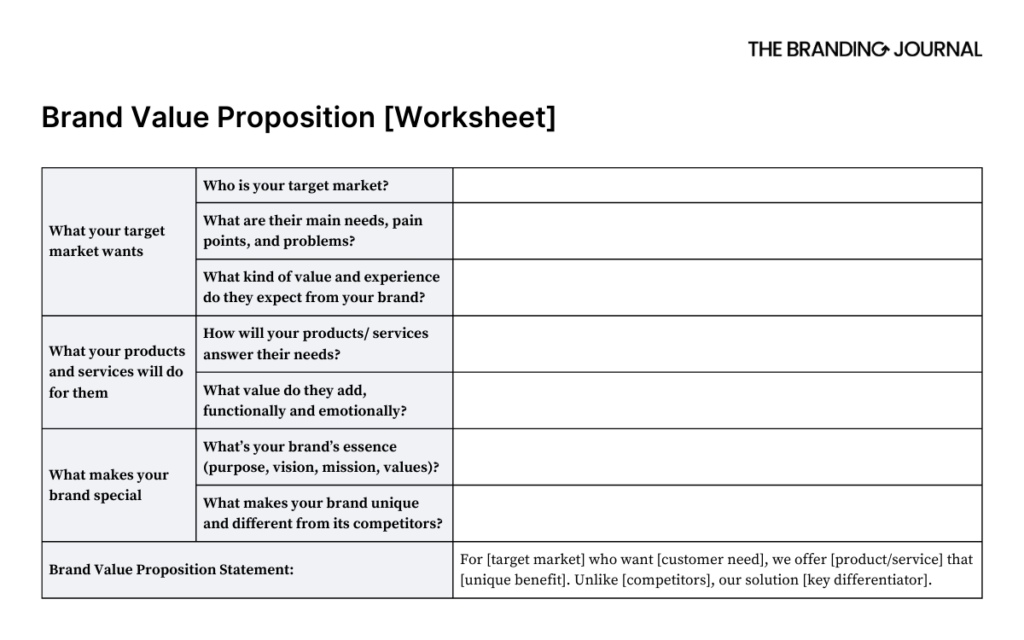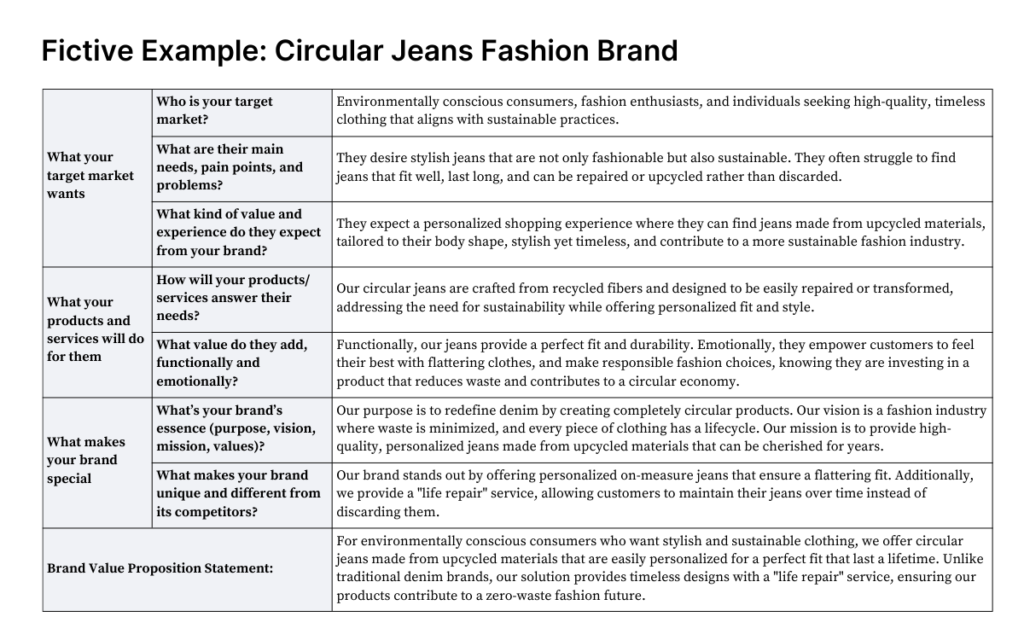What is the main challenge faced by brands?
One might think that securing investment, creating quality products, standing out, and making sales are the key obstacles brand owners encounter. These are indeed important, but if we want to put it simply, the main challenge for a brand is to matter to people – a simple yet profound goal.
And to matter to people, brands must be very clear about what is the exact value they can offer compared to competitors, and how to connect deeply with them. A good way to find this out is to define the brand’s value proposition.
Join us for this fun, simple exercise that will bring so much clarity to your business or strategic process!
Proven Systems for Business Owners, Marketers, and Agencies
→ Our mini-course helps you audit and refine an existing brand in 15 days, just 15 minutes a day.
→ The Ultimate Brand Building System is your step-by-step blueprint to building and scaling powerful brands from scratch.
Table of Contents
What Exactly Is a Brand Value Proposition?
A brand’s value proposition is a short statement explaining the benefits customers will gain from choosing a product or service. It shows why the offering is different and more valuable than competitors.
Think of it as a value exchange between your customers and your organization. If customers are going to give you money for your products and services, what value are you giving in exchange? What problems are you solving for them?
This clear message helps everyone in the company—like marketing, sales, and staff—understand their role in delivering that value to customers. It is also a central element of the Business Model Canva, showing how helpful it can be to help communicate the organization’s business model.
“Customers aren’t concerned with our problems, they just insist on capturing as much customer value as possible, and will go wherever the value seems greatest.”
– Paul Fifield
A brand’s customer value proposition is generally composed of two types of value:
- Functional value: Focuses on the practical benefits and features of the products and services. It answers how the product solves a problem or meets a need.
- Emotional value: Taps into the feelings and emotions of consumers. This type connects with customers on a personal level, often through storytelling.
Are Brand Value Propositions Solely Customer-Focused?
No, brand value propositions are not limited to just customers. They can be adapted to the diverse audiences that brands engage with.
Brands play a significant role in society and connect with a wide range of stakeholders, including employees, suppliers, investors, shareholders, and the general public. Additionally, brands impact local communities and the environment, which should be prioritized in their strategies and actions.
Because brands are entities that need to be economically viable, it is natural to start by defining the value proposition around customers’ needs. Once this is defined, the value proposition can be adapted and adjusted to the brand’s additional audiences. For example:
- Employer Value Proposition (EVP): Highlights what makes a company an attractive place to work. It includes aspects like company culture, benefits, career development opportunities, and work-life balance. More information here.
- Investor Value Proposition: Emphasizes the potential returns and benefits for investors. It showcases financial performance, growth potential, and strategic advantages of investing in the brand.
- Partner Value Proposition: Targets potential business partners or collaborators, explaining the mutual benefits of forming a partnership. This can include access to new markets, shared resources, or technological advantages.
- Supplier Value Proposition: Communicates the advantages for suppliers working with a brand, such as reliable partnerships, payment terms, and growth opportunities.
- Community Value Proposition: Focuses on the brand’s impact on the community or social responsibility efforts. This includes sustainability initiatives, charitable contributions, and community engagement.
These additional propositions are tailored to meet the specific interests and needs of each audience group.
How Can I Create a Value Proposition for My Brand?
There are many methodologies for building brand value propositions. After analyzing many resources, we have developed a proposed simple step-by-step approach that is part of our brand-building system.
Understand Where the Brand Value Proposition Sits Within a Brand Strategy Process
A brand’s value proposition is a crucial element in the brand-building process and should be developed after completing the initial steps of a brand strategy. These steps include:
- Conduct comprehensive research and analysis
Thoroughly examine the context in which the brand operates. This involves analyzing the environment, organization, and target customers. Significant market research is essential to understand the situation and audience before making any strategic decisions. - Define the brand’s essence
Clearly articulate the brand’s purpose, vision, mission, and values. This helps identify the brand’s heart and soul. - Establish a clear brand positioning strategy
Determine what makes the brand unique and different from competitors. This clarity is vital for effective communication and market differentiation.
Once this has been defined, you can use the above analysis and information to build your brand value proposition.
Create Your Customer-Oriented Brand Value Proposition
Start with the customer value proposition; we will see later how you can adapt it to the brand’s remaining audiences.

Step 1: Understanding the added-value of your brand
- What your target market wants: Ask yourself: Who is your target market? What are their main needs, pain points, and problems? What kind of value and experience do they expect from your brand?
- What your products and services will do for them: Ask yourself: How will your products/ services answer their needs? What value do they add, functionally and emotionally?
- What makes your brand special: Ask yourself: What’s your brand’s essence (purpose, vision, mission, values)? What makes your brand unique and different from its competitors?
Step 2: Define the value proposition in one statement:
For [target market] who want [customer need], we offer [product/service] that [unique benefit]. Unlike [competitors], our solution [key differentiator].

Extra Tip: Use the value proposition to define your brand’s promise
The brand promise is a commitment to deliver the value and experience that the brand strives to represent and provide for its customers at any given time. It is derived from the brand positioning and value proposition, serving as an invisible contract in which the brand guarantees a certain result and experience for its customers.
Use the value proposition statement to create your brand promise in one sentence, and make things clearer for your brand strategy. Remember: a brand promise is one of the most crucial elements of a brand strategy and should always be fulfilled!
Adapt the Brand Value Proposition to the Remaining Audiences
Once you have your brand value proposition, you can use it as a base and adjust it to your brand’s key audiences, depending on its context. For example:
- Employees
- Community and nature
- Investors and shareholders
- Suppliers
- Service providers
- Partners and distributors
- Governments
Ask yourself:
- Do the brand value proposition and promise also apply to the brand’s remaining key audiences?
- If not, adjust it to their specific needs.
Key Takeaways
- Importance of Brand Value Proposition: A strong brand value proposition is crucial because it clarifies what value your brand actually brings and makes your brand matter to consumers. When customers clearly understand your brand’s unique benefits, they are more likely to choose you over competitors.
- Beyond Customers: While customers are a primary focus, a brand value proposition should also be adapted for other key audiences, such as employees, investors, suppliers, and the community. Each group has its own interests and needs, and addressing these is vital for your brand’s overall impact and reputation.
- Timing in the Brand-Building Process: Developing your brand value proposition is a vital step in the brand-building process. It should be done after conducting thorough research and defining your brand’s essence and positioning. This value proposition not only guides your messaging but also feeds into the creation of a brand promise, outlining what customers can expect from their experience with your brand.
We’d love to hear from you!
What unique benefits does your brand offer that you think really sets it apart?
How do you plan to connect with your different audiences through your value proposition? Let’s chat in the comment section!
References
- Fifield, P. (2008). Book: Marketing Strategy Masterclass. Routledge. Page 437.









